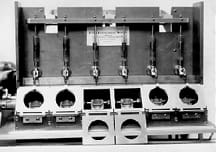Homeopathic remedies are prepared in the following manner:

Remedies made from soluble substances. Soluble substances are dissolved in alcohol to form a “mother tincture”. One part of this tincture is added to 99 parts of alcohol and succussed (shaken). This yields a 1C potency (one part per hundred).
This process of serial dilution and succussion is repeated, each step yielding a more dilute but more potent remedy. Repeating the process 10 times yields a 10C potency, one hundred times yields a 100C potency and so on.
The dilution can be administered in water, on tiny sugar pellets, in tablet form or a drop can be placed on a small bit of milk sugar and given to the patient.
Remedies made from insoluble substances. Insoluble substances are triturated (ground up) with lactose. One part substance to 99 parts lactose (milk sugar) yields a 1C potency. Serial trituration is continued as above to achieve the higher potencies. After several serial triturations the mixture is now soluble and the processing can continue with alcohol.
Potencies measured using “X” rather than “C”. Sometimes remedies are made on a decimal scale. Serial succussion or trituration for an X potency uses one part substance in 9 parts alcohol or lactose.
Remedies are not mere dilutions. Homeopathic remedies are not mere dilutions. The trituration and succussion process is intended to somehow “strip away” the material aspect of the substance while intensifying its “energy signature”. It is this “energy” which is thought to somehow stimulate the patient’s vital force.
Despite over 200 years of clinical efficacy, the nature of how these remedies work is still a mystery. We do not yet possess the technology or the methodology necessary to unlock homeopathy’s secrets and each generation of homeopaths has its favorite theory. The answers must await future generations of scientists to uncover.